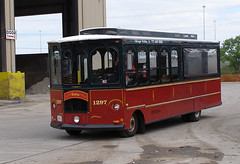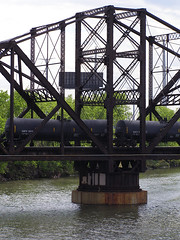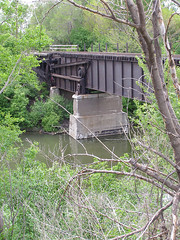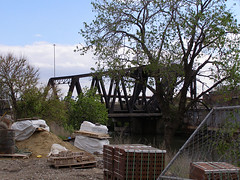Last Sunday I went on one of the tours put on for the city Great Places & Spaces architecture festival. As usual we arrived at 7am to join a block-long line of architecture fans waiting to sign up on the free tours. And as usual several of the most interesting tours filled up before we made our way up to the sign-up sheets.
But this tour sounded interesting, a trolley tour of movable bridges along the South Branch of the Chicago River, lead by structural engineer Joseph Abruzzo.
Chicago's flat terrain and multitude of railroads and streets intersecting with the small river have created an ideal place for experimentation in movable bridge technology. The city has more movable bridges than anywhere else in the world, of many types. Our 3-hour tour included stops at five bridges to show a wide variety.
Our first stop was on the grounds of a recycling yard where we could get a look at the Chicago Northwestern railroad swinging bridge, built in 1897 at the time of the construction of the Sanitary Canal. There are several of these turning bridges along this reach of the canal, all completed as the canal was excavated beneath them.
Next our guide took us to look beyond some brush at the corner of the recycling yard where we could glimpse a rare early type of lift bridge, the Rall Bascule Bridge over a freight slip off the river. Patented by Theodore Rall, this bridge features a large counterweight hidden between the tracks behind the pivot axle, and a linkage which pulls the bridge backwards as it lifts, thereby providing more clearance for boats. The overgrown weeds and rusty tracks indicated that its no longer used.
Next, we boarded the trolley again and headed upstream. We passed by the most spectacular bridges along the South Branch, the four matching Scherzer-type rolling bascules near Western Avenue, completed in 1910. But our next stop was to see the Paige Bascule bridge over Bubbly Creek. New construction along the creek will soon block off the limited view we had: the best place to see the bridge is from the Ashland Ave station on the Orange Line.
Our guide demonstrated the complex movements of this bridge using a cardboard mockup. The counterweight of the bridge is suspended horizontally above the roadbed just behind the pivot point. As the bridge lifts, the counterweight tilts downward, guided along gears rolling along the distinctive wavy rack of teeth on the struts of the bridge.




